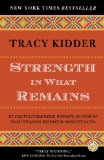Summary | Excerpt | Reading Guide | Reviews | Beyond the Book | Read-Alikes | Genres & Themes | Author Bio

Critics' Opinion:
Readers' Opinion:
First Published:
Aug 2009, 304 pages
Paperback:
May 2010, 304 pages
 Book Reviewed by:
Book Reviewed by:
Amy Reading
Buy This Book
This article relates to Strength in What Remains
The 1993 Burundian genocide (which preceded the 1994 genocide in Rwanda) traces back to the end of Belgian colonial rule in the 1950s and 1960s and the first Berudian genocide of 1972. Burundian history fits, like interlocking puzzle pieces, with that of its northern neighbor, Rwanda (map of Central Africa).
Like in Rwanda, Hutus make up about 86% of the population in Burundi, with only about 13% Tutsis (the remaining 1% are Twa pygmies). Unlike in Rwanda, where the Hutu majority took power, the small Tutsi elite in Burundi held onto government and military positions after independence. In April 1972, there was a bloody Hutu uprising which prompted an even more grisly retaliation by the Tutsi military. The Tutsis systematically killed Hutu intellectuals, politicians, and professionals as well as the insurgents. Estimates of the dead vary greatly, but most agree at least 100,000 people were killed, and maybe as many as 300,000.
Many Hutus fled Burundi for neighboring countries, including Rwanda where they were the majority in power. In Burundi, the Tutsi government maintained silence on the issue of ethnicity, even removing the labels of "Tutsi" and "Hutu" on identity cards (there are no physical differences to tell the two groups apart; the stereotype that Tutsis are tall and thin while Hutus are short, stocky, and broad-nosed does not hold).
Meanwhile, Tutsis who had fled Rwanda during the post-independence era were fomenting unrest under the guise of the Rwandan Patriotic Front in Uganda. They invaded Rwanda in 1990 and successfully held onto a bit of territory, prompting the Hutu military to retaliate against other Tutsis in the country.
Then in 1993, Burundians elected their first Hutu president, Melchior Ndadaye. On October 22, 1993, Ndadaye was assassinated, setting off a chain of violence. As Deo first heard the news from a fellow medical student, "President Ndadaye’s been killed, and they say he was killed by some Tutsis in the army, and now the war is going on, the Hutus are retaliating and killing every Tutsi all over the country." As many as 25,000 Tutsis were killed, and in 2002 the United Nations International Commission of Inquiry for Burundi labeled the massacre a genocide.
Burundi’s civil war amplified the tensions between Hutus and Tutsis in Rwanda, leading to the better-known Rwandan genocide. In April of 1994, the Hutu president of Rwanda and the Burundian president elected to replace Ndadaye, also a Hutu, were assassinated together when their jet was shot down. Over the next 100 days, as many as 800,000 Tutsis and Hutu moderates were slaughtered in a stunningly well-organized campaign of terror.
Links to information about Deogratias (Deo) Niyizonkiza
Filed under People, Eras & Events
![]() This "beyond the book article" relates to Strength in What Remains. It originally ran in September 2009 and has been updated for the
May 2010 paperback edition.
Go to magazine.
This "beyond the book article" relates to Strength in What Remains. It originally ran in September 2009 and has been updated for the
May 2010 paperback edition.
Go to magazine.





The House on Biscayne Bay
by Chanel Cleeton
As death stalks a gothic mansion in Miami, the lives of two women intertwine as the past and present collide.

The Flower Sisters
by Michelle Collins Anderson
From the new Fannie Flagg of the Ozarks, a richly-woven story of family, forgiveness, and reinvention.

The Funeral Cryer by Wenyan Lu
Debut novelist Wenyan Lu brings us this witty yet profound story about one woman's midlife reawakening in contemporary rural China.
Your guide toexceptional books
BookBrowse seeks out and recommends the best in contemporary fiction and nonfiction—books that not only engage and entertain but also deepen our understanding of ourselves and the world around us.